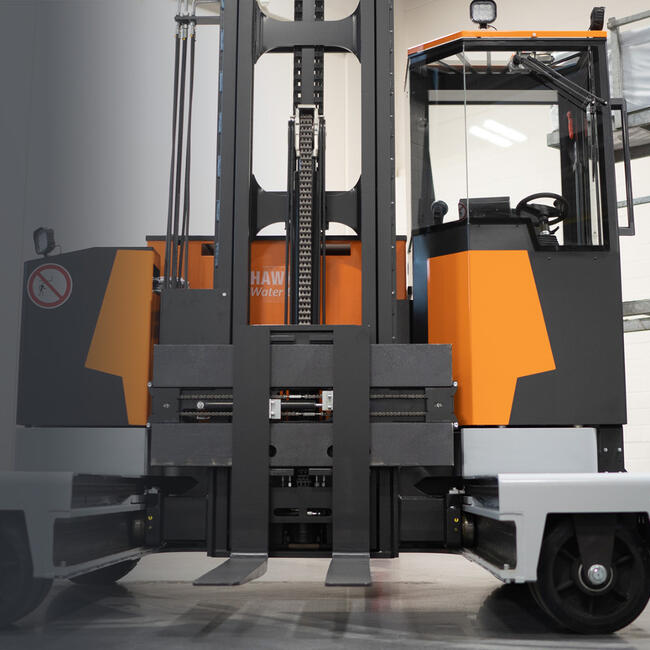More and more companies are making the decision to purchase used forklifts. Buying used equipment is much more economical than buying new. Of course, it is important that the used forklift still delivers on quality. Used forklifts in all conditions are available on the market, from like-new forklifts to items in need of repair. When you make your purchase, there are many aspects of the truck that must be checked. Some faults would only be picked up by a specialist.
Important factors to note when buying a used forklift
This checklist for used forklifts will provide you with practical tips for inspecting and checking your future forklift. The list of points takes you through every step of the inspection, from external condition to individual components and their function.
Forklift properties and use
Before snapping up a bargain, ask yourself is this the right truck for the intended purpose? Does the truck fit through the clearance heights and aisle widths? It is important to know from the outset where the truck will be used. The required conditions and properties can then be defined. Ideally, the following points should be clarified before purchase:
- Existing aisle widths
- Existing headroom
- Intended area of use (indoors/outdoors)
- Existing terrain & subsoil
- Lifting loads to be achieved
- Lift heights to be reached
- Assistance systems required
- Sensors required
- Cameras required
Engine & hydraulics
A key aspect when choosing a type of engine is the place of use. Should the forklift be used exclusively in enclosed buildings, both indoors and outdoors, or primarily on site? The place of use largely determines which type of drive (electric or combustion engine) is suitable for the forklift.
- The core components of a forklift truck or industrial truck are the engine and hydraulics. Carry out a function test!
- Is there any loss of hydraulic fluid or engine oil?
- Is the engine running?
- Do the hydraulics work?
- Has the maintenance schedule been observed?
Lift mast & forks
The lift masts and forks are subjected to particularly high mechanical loads during operation, therefore particular care should be taken with used trucks to ensure that these parts are in order.
- Does the attached mast match the type plate of the truck?
- Can all movements be performed without problems?
- Do the mast and fork give way under the load?
- Is there any damage to components?
- Are there cracks in the forks or their brackets?
- How many hours are shown on the operating hours counter?
Lighting & headlamps
- As well as being subject to possible internal regulations, lighting and headlamps are also important for safety.
- Are all lights and headlamps working?
- Are cables and plugs free of damage?
- Are the lamp housings free of moisture?
Electrical system & battery
With an electric forklift, the condition of the battery is an important criterion in determining the sales price.
- Are there traces of sulphation (green/white crystals) on the battery terminals?
- Are the battery cells inflated and bulging outwards?
- Are there cracks in the battery case?
- Have individual battery cells already been replaced?
Driver's cab & workplace
Everything should be present and in good working order. After all, even small items can add up to big costs that you didn't factor.
- All functional elements and displays must be complete and functioning correctly
- Panels and dashboard should not have any cracks
- Do the doors open and close smoothly?
- Are the wipers and windshield washers working?
- Does the cab light work?
- Are all standard mirrors present?
Tires
Buying new tires can be a significant cost factor. Check the existing tires so you can estimate the upcoming tire costs. Well maintained tires without significant wear are a good sign. Tires with nicks and large cuts will be approaching end of life.
- Is there any damage to the tires?
- Are there cuts or nicks?
- Is the wear mark (tire wear indicator) still clearly visible?
- Do the rims and wheel bolts look undamaged?
Steering & brakes
In addition to the engine, the brakes and steering are core components that demand uncompromising quality. Safety is the keyword here. When performing a function test on the brakes, check for an even braking effect. Obvious damage or missing parts could lead to unpredictable repair costs in the near future. Leaks in the brake system impair safe operation.
- Is the forklift directionally stable?
- Is there a lot of play in the steering?
- Are the service brakes and parking brakes OK?
- Is the braking effect even on both sides?
- Are the rubber pedals in usable condition and non-slip?
Body
The body of the truck must be checked for obvious flaws or signs of damage. A used forklift that does not look well maintained or has dents on the body indicates poor handling of the vehicle.
- Is rust damage visible on the body?
- Are there dents or deformations?
- Have individual parts been replaced?
Documents, warranties & guarantees
Are all papers, test reports and documents available and complete? A look at the warranty documentation tells you how long the warranty lasts, what it covers and what is excluded.
- Is the truck still under guarantee?
- Is the test report available?
- Are the identification documents complete?
A personal inspection of the truck provides significantly more information about its condition than written information. If defects are found during the inspection, the buyer must decide whether they are willing to accept these defects and whether the sale price takes into account any necessary repairs.

